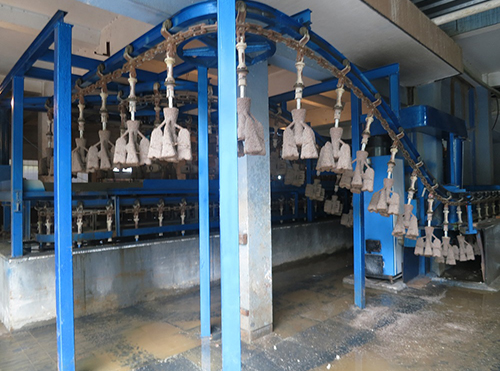Silica-sol precision casting, also known as silica sol investment casting or colloidal silica casting, is a specialized variant of the investment casting process. It is commonly used for producing high-precision and complex-shaped components with excellent surface finish and dimensional accuracy. The silica-sol process offers several advantages over traditional investment casting methods, particularly when it comes to casting intricate and delicate parts.
The silica-sol precision casting process involves the following steps:
- Pattern Creation: Just like in traditional investment casting, the process begins with the creation of a pattern or replica of the desired part. The pattern can be made from wax, plastic, or other materials. The pattern is designed to have a slight taper to facilitate its removal from the mold.
- Mold Assembly: The patterns are attached to a central sprue to form a cluster, similar to the assembly in traditional investment casting.
- Shell Building: The pattern cluster is then dipped into a ceramic slurry made of fine silica particles suspended in a liquid binder (usually water-based colloidal silica). After each dip, the cluster is coated with a layer of fine ceramic stucco or refractory material. This process is repeated multiple times to build up a thick and strong ceramic shell around the pattern cluster. The shell is usually built up in layers of increasing coarseness to provide better strength and support during the casting process.
- Dewaxing: Once the ceramic shell is fully dried and hardened, the entire assembly is heated to melt and remove the wax or plastic patterns, similar to the dewaxing step in traditional investment casting. This leaves behind a hollow ceramic mold with cavities corresponding to the desired part.
- Preheating: After dewaxing, the ceramic shell is preheated to a specific temperature to remove any remaining moisture and ensure the mold is ready to withstand the high temperature of the molten metal.
- Pouring: The preheated ceramic shell is securely placed in a flask and molten metal, such as stainless steel, carbon steel, or other alloys, is poured into the mold through the sprue. The metal fills the cavities of the ceramic shell, taking the shape of the desired part.
- Solidification: Once the mold is filled, the molten metal is allowed to cool and solidify, just like in traditional investment casting. The solidification process ensures that the metal takes on the precise shape and properties of the desired part.
- Cooling and Shell Removal: After solidification, the entire mold is allowed to cool. Once the metal has cooled sufficiently, the ceramic shell is carefully broken or removed, revealing the solidified precision casting.
- Finishing: The castings are then subjected to various finishing processes, including removal of excess material, grinding, polishing, heat treatment, and machining, to achieve the final dimensions, surface finish, and desired mechanical properties.
The silica-sol precision casting process provides excellent dimensional accuracy, surface finish, and intricate detail reproduction. The use of silica sol as the binder in the ceramic slurry allows for finer and smoother surface finishes compared to traditional investment casting methods. This makes it particularly suitable for casting complex and delicate components used in industries such as aerospace, automotive, and precision machinery.

Why is the casting process for silica-sol precision castings so expensive?
The lost wax casting method simply replicates the object to be cast, using wax, which is then immersed in sand/powder, allowed to dry and then covered with a sand film over the wax image. These steps are repeated until the outer film is sufficient to support the flow process. The wax in the mould is then melted and the mould is pulled out. After this, the mould needs to be heated several times to increase its hardness before it can be used for casting. This method is more accurate but more costly due to the high price of sand/powder and the complexity of multiple heating for production.
The silica-sol method of casting produces products with a surface roughness of RA 3.2 ~ 6.3. Since the cast billets are almost formed, machining or small amounts of machining can be avoided, reducing costs and production times to a certain extent.
There is also a more common method of lost wax casting using the water-glass process, which has certain price advantages compared to the casting water-glass produced by the silica-sol process, i.e. it is cheaper. This is a brief analysis of the differences between the two processes.
The differences in the manufacturing processes lead to significant differences in the final product. Products produced by the silica-sol process have higher dimensional accuracy and better surface roughness than those produced by the water-glass process. If you care more about quality, respect the price; if you want a cheaper product, accept its drawbacks! What you get depends on how much you pay.
To conclude, the core advantages of silicone precision castings are summarised: Good surface finish and high dimensional accuracy of the castings, which saves a lot of surface preparation time and outsourced machining of dimensions. From the point of view of the finished product, it actually reduces costs.
Complex stainless steel precision castings tempering has two main purposes: one is to eliminate the stress of the quenching process; two feet to promote the quenching of martensite and residual austenite sub-stable tissue decomposition and transformation.
The tempering temperature is lower than the eutectic transformation temperature, usually about 650 ℃, holding time of not less than 2 hours. As the tempering temperature rises, the martensite precipitation of carbon from the supersaturated state precipitation, the formation of dispersion of fine carbide. Martensite eventually formed a block ferrite. Therefore, “precision casting stainless steel” steel hardness will gradually decrease with the increase of tempering temperature.
One of the problems that cannot be ignored is brittleness during tempering:
brittleness in the low-temperature zone from 300°C to 400°C and in the high-temperature zone from 500°C to 650°C. When carbon atoms precipitate out, a thin layer of carbide forms at the grain boundaries, producing an effect known as low-temperature embrittlement. This carbide is called e-carbide and has a different structure and composition to carbide, resulting in a reduction in impact toughness known as low temperature temper brittleness. When the concave fire continues to heat up, the formation of a stable tempering structure, the second tempering treatment no longer appear temper brittleness, so also known as “irreversible temper brittleness”. In 450 ℃ ~ 650 ℃ high temperature tempering brittleness and cooling rate is different, there are many tempering slow cooling brittleness, no tempering fast cooling brittleness. High-temperature tempering brittleness is reversible, as long as the steel with tempering brittleness is removed, and then heated to 600 ℃ “(: above, and then slowly cooled, will still appear tempering brittleness. Temper brittleness may therefore be related to the precipitation of low melting point brittle compounds at grain boundaries. The addition of molybdenum to certain alloy steels can eliminate their low-temperature temper brittleness. Experts generally agree that molybdenum and other alloying elements may form composite carbides that counteract the adverse effects of carbides.
Tempering temperatures can be divided into low tempering, medium tempering and high tempering according to the different requirements for the performance of the casting.
(1) Low temperature tempering at 100°C ~ 250°C forms carbide martensite, which is organised as fire martensite and partially supersaturated carbon martensite. The carbon content of this steel is very small, as is the supersaturated carbon in the martensite. As a result, the tempered martensite itself has good toughness, and the precipitation and stability of the carbides further increases the strength and hardness of the steel.
(2) Medium tempering temperature 300 ℃ ~ 500 ℃ tempering, tempering organization tempering transit, with good strength and toughness. The tempering process is widely used in low-alloy steel.
(3) high temperature tempering temperature 550 ℃ ~ 650 ℃ tempering, tempering organization dispersion, soxhlet grain size fine. Quenching + high temperature tempering process is called tempering quenching. Suitable for low-alloy steel, multi-element strong carbide forming, with high strength and high toughness.
